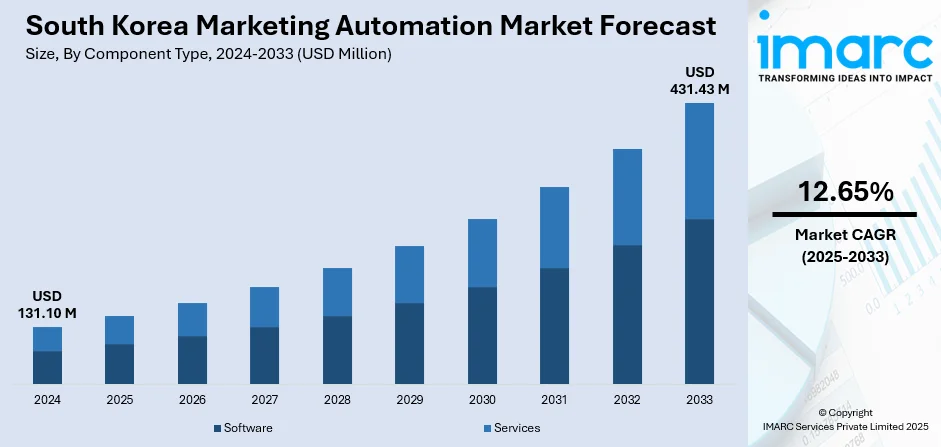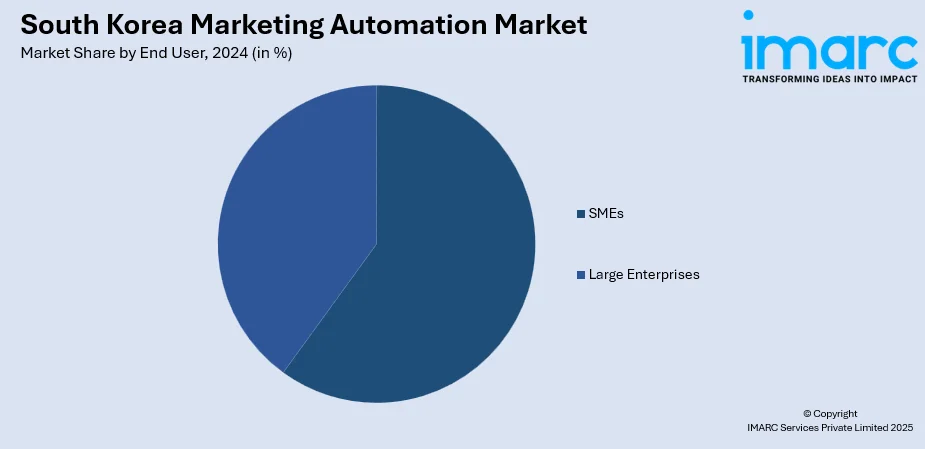
South Korea Marketing Automation Market Size, Share, Trends and Forecast by Component Type, Deployment Type, End User, Application, Vertical, and Region, 2025-2033
South Korea Marketing Automation Market Overview:
The South Korea marketing automation market size reached USD 131.10 Million in 2024. The market is projected to reach USD 431.43 Million by 2033, exhibiting a growth rate (CAGR) of 12.65% during 2025-2033. Businesses are investing more in digital channels, using automation to manage campaigns, target audiences, and improve returns. Artificial intelligence (AI) is enhancing this by enabling smarter segmentation, real-time personalization, and predictive analytics. Marketing automation tools are being employed by various companies to streamline multichannel marketing, reduce manual effort, and deliver better customer experiences. Besides this, rising internet penetration is fueling the South Korea marketing automation market share.
|
Report Attribute
|
Key Statistics
|
|---|---|
|
Base Year
|
2024
|
|
Forecast Years
|
2025-2033
|
|
Historical Years
|
2019-2024
|
| Market Size in 2024 | USD 131.10 Million |
| Market Forecast in 2033 | USD 431.43 Million |
| Market Growth Rate 2025-2033 | 12.65% |
South Korea Marketing Automation Market Trends:
Increasing investments in digital advertising
Rising expenditure on digital advertising is positively influencing the market in South Korea. With businesses allocating more of their marketing budgets to digital platforms, such as social media, search engines, and online video, the demand for automation tools is growing. Businesses are employing marketing automation to handle and enhance their advertising efforts across various platforms, guaranteeing uniform messaging and improved effectiveness. As people are spending more time online, brands are under pressure to deliver timely, personalized, and engaging content. Automation helps by segmenting audiences, scheduling ads, and analyzing performance in real time. It reduces manual workload and enhances the precision of targeting, which improves return on ad spend. Businesses of all sizes, ranging from startups to large corporations, are wagering on automation platforms to keep up with the fast pace of digital marketing. As per the IMARC Group, the South Korea digital marketing market size reached USD 7.8 Billion in 2024. These tools also allow continuous testing and refinement of ads, ensuring that campaigns stay relevant and competitive. In South Korea’s digitally advanced economy, where mobile usage and e-commerce are widespread, digital advertising continues to grow rapidly. As this expenditure is increasing, the demand for intelligent marketing solutions that can scale efforts, measure outcomes, and support data-driven strategies is high. This trend is strongly supporting the expansion of the market across various industries in the country.

To get more information on this market, Request Sample
Rising AI adoption
Increasing AI adoption is impelling the South Korea marketing automation market growth. As businesses are seeking smarter and more efficient ways to reach their customers, AI-based tools are becoming essential for delivering personalized, data-oriented marketing strategies. AI assists in examining user actions, forecasting choices, and streamlining content delivery based on real-time insights. With AI, marketers can segment audiences more precisely, optimize email campaigns, and schedule social media posts at peak engagement times. It also enables dynamic content creation, chatbots for instant customer interaction, and predictive analytics that improve campaign performance. In South Korea’s highly connected and tech-savvy environment, companies are eager to leverage AI to stay competitive, reduce human error, and refine customer engagement. AI integration also supports multichannel campaign management, ensuring consistency across platforms like email and web. The growing reliance on intelligent automation is catalyzing the demand for advanced marketing platforms, making AI a central force in shaping the future of South Korea’s marketing automation landscape. As per industry reports, the size of the South Korea AI market is set to expand by 12.1% from 2024 and attain KRW 3.43 Trillion in 2025.
South Korea Marketing Automation Market Segmentation:
IMARC Group provides an analysis of the key trends in each segment of the market, along with forecasts at the country and regional levels for 2025-2033. Our report has categorized the market based on component type, deployment type, end user, application, and vertical.
Component Type Insights:
- Software
- Services
The report has provided a detailed breakup and analysis of the market based on the component type. This includes software and services.
Deployment Type Insights:
- On-Premises
- Cloud-Based
A detailed breakup and analysis of the market based on the deployment type have also been provided in the report. This includes on-premises and cloud-based.
End User Insights:

- SMEs
- Large Enterprises
The report has provided a detailed breakup and analysis of the market based on the end user. This includes SMEs and large enterprises.
Application Insights:
- Campaign Management
- Email Marketing
- Lead Nurturing and Lead Scoring
- Social Media Marketing
- Inbound Marketing
- Others
A detailed breakup and analysis of the market based on the application have also been provided in the report. This includes campaign management, email marketing, lead nurturing and lead scoring, social media marketing, inbound marketing, and others.
Vertical Insights:
- BFSI
- Retail
- Healthcare
- IT and Telecom
- Government
- Entertainment and Media
- Education
- Others
The report has provided a detailed breakup and analysis of the market based on the vertical. This includes BFSI, retail, healthcare, IT and telecom, government, entertainment and media, education, and others.
Regional Insights:
- Seoul Capital Area
- Yeongnam (Southeastern Region)
- Honam (Southwestern Region)
- Hoseo (Central Region)
- Others
The report has also provided a comprehensive analysis of all the major regional markets, which include Seoul Capital Area, Yeongnam (Southeastern Region), Honam (Southwestern Region), Hoseo (Central Region), and others.
Competitive Landscape:
The market research report has also provided a comprehensive analysis of the competitive landscape. Competitive analysis such as market structure, key player positioning, top winning strategies, competitive dashboard, and company evaluation quadrant has been covered in the report. Also, detailed profiles of all major companies have been provided.
South Korea Marketing Automation Market News:
- In April 2025, AnyMind Group, a company specializing in BPaaS for marketing, e-commerce, and digital transformation, unveiled a strategic alliance with NDsoft and NextPaper from South Korea to introduce a fully automated advertising solution designed for media firms, provided via NDSoft’s content management system (CMS). The upgraded solution would allow publishers to conveniently deliver banner and video advertisements alongside automated billing. The automated ad platform was set to officially launch in May 2025.
South Korea Marketing Automation Market Report Coverage:
| Report Features | Details |
|---|---|
| Base Year of the Analysis | 2024 |
| Historical Period | 2019-2024 |
| Forecast Period | 2025-2033 |
| Units | Million USD |
| Scope of the Report |
Exploration of Historical Trends and Market Outlook, Industry Catalysts and Challenges, Segment-Wise Historical and Future Market Assessment:
|
| Component Types Covered | Software, Services |
| Deployment Types Covered | On-Premises, Cloud-Based |
| End Users Covered | SMEs, Large Enterprises |
| Applications Covered | Campaign Management, Email Marketing, Lead Nurturing and Lead Scoring, Social Media Marketing, Inbound Marketing, Others |
| Verticals Covered | BFSI, Retail, Healthcare, IT and Telecom, Government, Entertainment and Media, Education, Others |
| Regions Covered | Seoul Capital Area, Yeongnam (Southeastern Region), Honam (Southwestern Region), Hoseo (Central Region), Others |
| Customization Scope | 10% Free Customization |
| Post-Sale Analyst Support | 10-12 Weeks |
| Delivery Format | PDF and Excel through Email (We can also provide the editable version of the report in PPT/Word format on special request) |
Key Questions Answered in This Report:
- How has the South Korea marketing automation market performed so far and how will it perform in the coming years?
- What is the breakup of the South Korea marketing automation market on the basis of component type?
- What is the breakup of the South Korea marketing automation market on the basis of deployment type?
- What is the breakup of the South Korea marketing automation market on the basis of end user?
- What is the breakup of the South Korea marketing automation market on the basis of application?
- What is the breakup of the South Korea marketing automation market on the basis of vertical?
- What is the breakup of the South Korea marketing automation market on the basis of region?
- What are the various stages in the value chain of the South Korea marketing automation market?
- What are the key driving factors and challenges in the South Korea marketing automation market?
- What is the structure of the South Korea marketing automation market and who are the key players?
- What is the degree of competition in the South Korea marketing automation market?
Key Benefits for Stakeholders:
- IMARC’s industry report offers a comprehensive quantitative analysis of various market segments, historical and current market trends, market forecasts, and dynamics of the South Korea marketing automation market from 2019-2033.
- The research report provides the latest information on the market drivers, challenges, and opportunities in the South Korea marketing automation market.
- Porter's five forces analysis assist stakeholders in assessing the impact of new entrants, competitive rivalry, supplier power, buyer power, and the threat of substitution. It helps stakeholders to analyze the level of competition within the South Korea marketing automation industry and its attractiveness.
- Competitive landscape allows stakeholders to understand their competitive environment and provides an insight into the current positions of key players in the market.
Need more help?
- Speak to our experienced analysts for insights on the current market scenarios.
- Include additional segments and countries to customize the report as per your requirement.
- Gain an unparalleled competitive advantage in your domain by understanding how to utilize the report and positively impacting your operations and revenue.
- For further assistance, please connect with our analysts.
 Request Customization
Request Customization
 Speak to an Analyst
Speak to an Analyst
 Request Brochure
Request Brochure
 Inquire Before Buying
Inquire Before Buying




.webp)




.webp)












